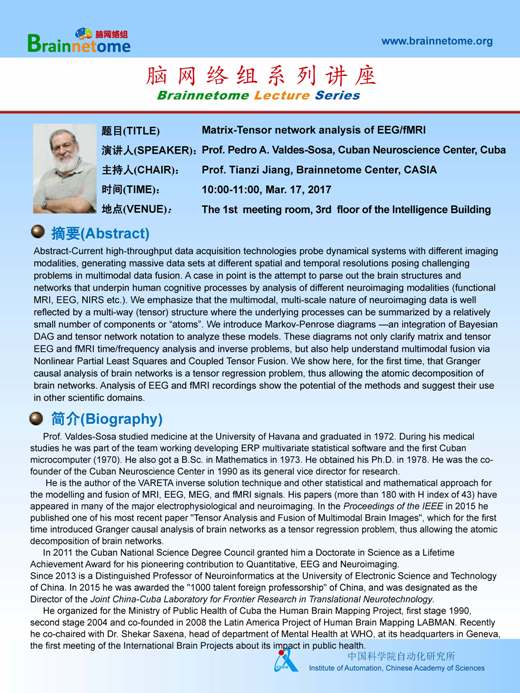Prof. Prof. Pedro A. Valdes-Sosa's Lecture: Matrix-Tensor network analysis of EEG/fMRI
Title: Matrix-Tensor network analysis of EEG/fMRI
Speaker: Prof. Pedro A. Valdes-Sosa, Cuban Neuroscience Center, Cuba
Chair: Prof. Tianzi Jiang, Brainnetome Center, CASIA
Time: 10:00-11:00, Mar. 17, 2017
Venue: The 1st meeting room, 3rd floor of the Intelligence Building
[Abstract]
Abstract-Current high-throughput data acquisition technologies probe dynamical systems with different imaging modalities, generating massive data sets at different spatial and temporal resolutions posing challenging problems in multimodal data fusion. A case in point is the attempt to parse out the brain structures and networks that underpin human cognitive processes by analysis of different neuroimaging modalities (functional MRI, EEG, NIRS etc.). We emphasize that the multimodal, multi-scale nature of neuroimaging data is well reflected by a multi-way (tensor) structure where the underlying processes can be summarized by a relatively small number of components or "atoms". We introduce Markov-Penrose diagrams —an integration of Bayesian DAG and tensor network notation to analyze these models. These diagrams not only clarify matrix and tensor EEG and fMRI time/frequency analysis and inverse problems, but also help understand multimodal fusion via Nonlinear Partial Least Squares and Coupled Tensor Fusion. We show here, for the first time, that Granger causal analysis of brain networks is a tensor regression problem, thus allowing the atomic decomposition of brain networks. Analysis of EEG and fMRI recordings show the potential of the methods and suggest their use in other scientific domains.
[Biography]
Prof. Valdes-Sosa studied medicine at the University of Havana and graduated in 1972. During his medical studies he was part of the team working developing ERP multivariate statistical software and the first Cuban microcomputer (1970). He also got a B.Sc. in Mathematics in 1973. He obtained his Ph.D. in 1978. He was the co-founder of the Cuban Neuroscience Center in 1990 as its general vice director for research.
He is the author of the VARETA inverse solution technique and other statistical and mathematical approach for the modelling and fusion of MRI, EEG, MEG, and fMRI signals. His papers (more than 180 with H index of 43) have appeared in many of the major electrophysiological and neuroimaging. In the Proceedings of the IEEE in 2015 he published one of his most recent paper "Tensor Analysis and Fusion of Multimodal Brain Images", which for the first time introduced Granger causal analysis of brain networks as a tensor regression problem, thus allowing the atomic decomposition of brain networks.
In 2011 the Cuban National Science Degree Council granted him a Doctorate in Science as a Lifetime Achievement Award for his pioneering contribution to Quantitative, EEG and Neuroimaging. Since 2013 is a Distinguished Professor of Neuroinformatics at the University of Electronic Science and Technology of China. In 2015 he was awarded the "1000 talent foreign professorship" of China, and was designated as the Director of the Joint China-Cuba Laboratory for Frontier Research in Translational Neurotechnology.
He organized for the Ministry of Public Health of Cuba the Human Brain Mapping Project, first stage 1990, second stage 2004 and co-founded in 2008 the Latin America Project of Human Brain Mapping LABMAN. Recently he co-chaired with Dr. Shekar Saxena, head of department of Mental Health at WHO, at its headquarters in Geneva, the first meeting of the International Brain Projects about its impact in public health.

